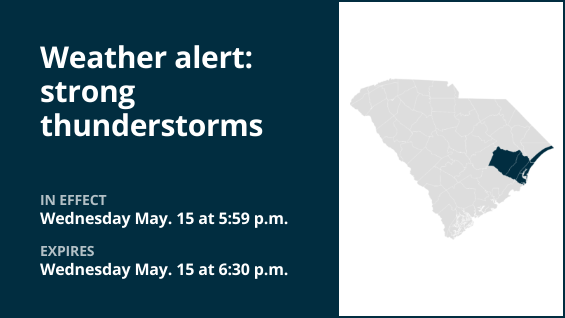The National Weather Service issued a weather alert at 5:59 p.m. on Wednesday for strong thunderstorms until 6:30 p.m. for Williamsburg, Horry and Georgetown counties.
Residents can expect wind gusts of up to 40 mph.
“At 5:58 p.m., Doppler radar tracked a strong thunderstorm over Warsaw, or 17 miles northwest of Georgetown, moving east at 30 mph,” states the weather service. “Gusty winds could knock down tree limbs and blow around unsecured objects.”
Locations impacted by the alert include Surfside Beach, Pawleys Island, Garden City, Murrells Inlet, Andrews, Rhems, Warsaw, Burgess, Oatland, Plantersville, Litchfield Beach, Morrisville and Waccamaw Community Hospital.
The weather service adds, “If outdoors, consider seeking shelter inside a building. A Severe Thunderstorm Watch remains in effect until 8 p.m. for northeastern South Carolina.”
This alert is in effect until 6:30 p.m.

Preparing for impending lightning strikes: Expert safety recommendations
Each year, lightning strikes the United States approximately 25 million times, with the majority of these electrifying events occurring during the summer months. Unfortunately, lightning is responsible for claiming the lives of approximately 20 people annually, as reported by the weather service. The threat of lightning becomes more pronounced as thunderstorms draw nearer, peaking when the storm is directly overhead and gradually waning as it moves away.
To ensure your safety during a thunderstorm, consider the following recommendations:
1. Lightning safety plan:When venturing outdoors, it’s vital to establish a clear plan for seeking shelter in case of lightning.
Monitor the sky for threatening signs and listen for the sound of thunder. If thunder is audible, it’s an indication that lightning is nearby.
Seek a safe place to shelter, preferably indoors.
2. Indoors safety measures:Once you’ve found shelter indoors, abstain from using corded phones, electrical appliances, or plumbing fixtures, and refrain from approaching windows and doors.
These precautions help reduce the risk of electrical surges, as lightning can follow conductive pathways.
3. Wait for the all-clear:After the last lightning strike or thunderclap, wait at least 30 minutes before resuming outdoor activities.
Lightning can strike even when a storm has seemingly passed, so exercise caution.
When indoor shelter isn’t available:If you find yourself outdoors without access to indoor shelter during a thunderstorm, take these steps to maximize your safety:
Avoid open fields, hilltops, or ridge crests, as they expose you to greater lightning risk.
Steer clear of tall, isolated trees and other prominent objects. In forested areas, stay close to lower stands of trees.
If you’re in a group, ensure that individuals are spaced out to prevent lightning current from transferring between people.
Camping in an open setting during a thunderstorm is strongly discouraged. If no alternative exists, set up camp in a valley, ravine, or other low-lying areas. Remember that a tent offers no protection against lightning.
Do not approach water bodies, wet objects, or metal items. Although water and metal do not attract lightning, they conduct electricity effectively and can pose significant risks.
In summary, when facing the threat of lightning, vigilance and preparedness are your best allies. By following these guidelines, you can significantly reduce the chances of lightning-related accidents and prioritize your safety.
Rainy roadways ahead: Essential safety tips for heavy rain
When heavy rain sets in, the risk of flooding and hazardous driving conditions rises. Whether it’s prolonged rainfall or rapid runoff, being prepared is essential. Here are some valuable safety tips from the weather service to ensure you stay safe in heavy rain:
Beware of swollen waterways:In heavy rain, refrain from parking or walking near culverts or drainage ditches, where swift-moving water can pose a grave danger.
Maintain safe driving distances:Adhere to the two-second rule for maintaining a safe following distance behind the vehicle in front of you. In heavy rain, allow an additional two seconds of distance to compensate for reduced traction and braking effectiveness.
Slow down and stay cautious:If it is raining and the roads are wet, slow down. Take your foot off the accelerator and let your speed drop gradually. Never use the brakes suddenly because this may cause the car to skid.
Choose your lane wisely:Stick to the middle lanes to minimize the risk of hydroplaning. Outer lanes are more prone to accumulating water.
Visibility matters:Enhance your visibility in heavy rain by activating your headlights. Be particularly vigilant for vehicles in blind spots, as rain-smeared windows can obscure them.
Watch out for slippery roads:Be extra careful during the first half hour after rain begins. Grime and oil on the road surface mix with water to make the road slippery.
Keep a safe distance from large vehicles:Large trucks and buses can reduce your visibility with tire spray. Avoid tailgating and pass them swiftly and safely.
Mind your windshield wipers:Heavy rain can overload the wiper blades. When visibility is so limited that the edges of the road or other vehicles cannot be seen at a safe distance, it is time to pull over and wait for the rain to ease up. It is best to stop at rest areas or other protected areas.
If the roadside is your only option, pull off as far as possible, preferably past the end of a guard rail, and wait until the storm passes. Keep your headlights on and turn on emergency flashers to alert other drivers of your position.
By following these safety measures, you can significantly reduce risks and ensure your well-being when heavy rain pours down. Stay informed about weather conditions and heed advice from local authorities to make your journey safe and sound.







